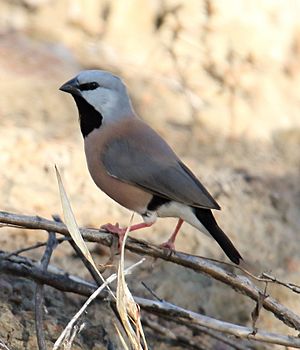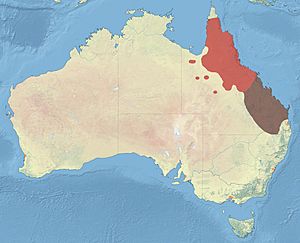Black-throated finch facts for kids
Quick facts for kids Black-throated finch |
|
|---|---|
 |
|
| The nominate, white-rumped southern subspecies, Poephila cincta cincta | |
| Conservation status | |
| Scientific classification | |
 |
|
| Distribution |
The black-throated finch (Poephila cincta), also called the parson finch, is a small bird found in grassy woodlands across north-east Australia. You can spot them from Cape York Peninsula down to central Queensland. There are two main types, or subspecies, of this finch. The Southern black-throated finch (Poephila cincta cincta) is in danger of disappearing, and its home is shrinking because of new buildings and farms. It has already vanished from New South Wales. Luckily, the Northern black-throated finch (Poephila cincta atropygialis) is not currently considered threatened.
Contents
What is a Black-throated Finch?
The black-throated finch is a type of estrildid finch, which is a family of small, seed-eating birds. This bird was first described by a scientist named John Gould in 1837. He gave it the scientific name Amadina cincta, and cincta means "girdled" in Latin, which might refer to the band of color on the bird.
Scientists have studied the genes of these birds. They found that the black-throated finch separated from its close relative, the long-tailed finch, about 600,000 years ago. The name "Black-throated finch" is its official common name.
Different Types of Black-throated Finches
There are two main types, or subspecies, of the black-throated finch. They look a bit different and live in different areas:
- The black-rumped subspecies (Poephila cincta atropygialis) is also known as the northern black-throated finch. It lives north of Cairns and might be moving further south.
- The white-rumped subspecies (Poephila cincta cincta) is also known as the southern black-throated finch. It lives south of Townsville.
Sometimes, you might find birds that are a mix of both types where their living areas meet.
What Does a Black-throated Finch Look Like?
This finch is quite small, usually about 10 cm (4 in) long. It has a short black beak and a black patch around its eyes and throat. This black patch stands out against its light grey head. Its wings, chest, and belly are a soft pinkish-brown color. The tail is short and black.
The main difference between the northern and southern types is the color of their rump (the area just above the tail). Northern finches have a black rump, while southern finches have a white rump.
These birds also have different calls. Their sounds are similar to the long-tailed finch but are lower in tone. Scientists have found up to twelve different calls, and even the two subspecies have slightly different sounds.
Where Do Black-throated Finches Live?
Black-throated finches used to live all the way from Cape York Peninsula in the north, through eastern Queensland, and into north-eastern New South Wales. However, they haven't been seen in New South Wales since 1994.
These finches usually stay in one area, but they might move around locally. They prefer open forests with lots of grass, especially near water sources like rivers.
How Do Black-throated Finches Behave?
Black-throated finches often live in groups, sometimes with up to 30 birds. They form strong pairs that stay together. These pairs might live alone or in small groups of six or more pairs. They usually look for food close to their nest, which they use for breeding or for sleeping at night.
If food or water is scarce, especially during dry times, many pairs might gather together. They can even form large flocks to travel to water sources.
Breeding and Nests
Black-throated finches usually breed between September and January in the southern parts of their range. In the north, they breed after the monsoon season, starting in February. They can lay one or two sets of eggs during this time.
Their nest is round and made from dried grasses. It has a tube-like entrance and is usually built high up in a eucalyptus tree, about 5 meters (16 feet) off the ground. The female lays four to six matte white, oval-shaped eggs, each about 12 by 17 mm (0.5 by 0.7 in).
What Do Black-throated Finches Eat?
The main food for black-throated finches is seeds from different types of grass. They also eat spiders and ants. They usually look for fallen seeds on the ground. Sometimes, they can even pick seeds directly from the plant. They might bend a plant stem down to reach the seeds, holding it with their foot against the ground.
Larger groups of finches might gather to feed in areas where there has been a recent bushfire, as this can make seeds more accessible. During breeding season, they also hunt flying termites, catching them on the ground or in the air. Young finches learn to shake off the termites' wings before eating them. Spiders are also a tasty treat they pluck from webs.
These finches can drink water by partly opening their beak and dipping it in. They usually drink in the morning or evening, unless water is easily available all day.
Black-throated Finches and People
Black-throated finches are popular birds that can be kept and bred in captivity. In 2019, the black-throated finch won "Australian Bird of the Year" in an online poll. This was largely because people were worried about the southern subspecies, which had only about 800 birds left at the time of the poll.
Saving the Black-throated Finch
Over the past few decades, the number of black-throated finches has gone down. The northern subspecies is not considered at risk in Queensland. However, the southern subspecies is listed as "Endangered" by the Australian government.
The main reasons for their decline are:
- Farming and grazing: More land is being used for farms and cattle, which takes away their natural habitat.
- Changes in fire patterns: How fires are managed in their habitat has changed, which affects the plants they rely on.
- More woody weeds: Some native woody plants are growing too much in their grassy homes, making it harder for the finches to find food and space.
A plan to manage the finch population was made in 2004, but the numbers of southern finches continued to drop. By 2012, they were considered locally extinct or very rare in many areas where they used to be common.
In New South Wales
The southern black-throated finch was declared threatened in New South Wales. In 2016, it was officially listed as "presumed extinct" in the state. This means scientists believe it no longer lives there, mainly due to the loss of its habitat.
In Queensland
In Queensland, the southern subspecies was listed as "vulnerable" in 2007. It seemed to have disappeared from 80% of the areas where it once lived. By 2008, most of the remaining birds were near Townsville, and new buildings were threatening their homes. In 2020, the bird was listed as "Endangered" in Queensland.
A company called Adani Australia created a plan in 2018 to manage the finch because their proposed Carmichael coal mine is in the finch's habitat. The plan suggested clearing land slowly to make the finches move away. However, many scientists criticized this plan, saying it wasn't good enough to protect the birds.
Images for kids
Error: no page names specified (help). In Spanish: Diamante gorjinegro para niños
In Spanish: Diamante gorjinegro para niños




